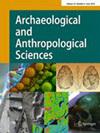The Later Stone Age site Faraoskop Rock Shelter yielded the human remains of twelve individuals in an ash-rich sedimentary sequence that also preserved anthropogenic bedding features. This geoarchaeological study is concerned with the sedimentary context of the human remains, the reconstruction of the human activities that formed the ash deposits as well as the bedding features and the paleoenvironmental conditions during site occupation. To investigate these topics, we employed micromorphological analyses on the deposits coupled with micro-Fourier-Transform-Infrared spectroscopy and phytolith analysis. This approach enabled us to reconstruct site use patterns as well as paleoenvironmental conditions. Our analysis shows a break in site occupation between the Pleistocene and Holocene deposits at the site and before and after the interment of the 12 individuals. The Holocene ash deposits pre-dating the interments result from continuous use of hearths at a central location of the shelter with an increase in fire intensity over time. Site occupants also repeatedly used plant bedding features as living surfaces around the fires and phytolith analysis revealed the particular use of eudicots for some of these bedding features. The occupation of the site took place during grassland regimes with a shift to a shrubbier environmental context during the Holocene. Unfortunately, the direct interment context of the human remains was not available for this study and it remains open what cultural practises may have been preserved in the burial sediments.


